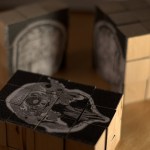neuroscience
Yesterday afternoon, I watched the livestream of the "All Creatures Great and Smart" session of the World Science Festival in New York City. The session was absolutely fantastic, and featured Brian Hare, Vanessa Woods, Jeremy Niven, Patrick Hof and Klaus Zuberbühler.
The conversation challenged long-held assumptions about the differences between "animal" and "human", and included fascinating discussion about pin-sized brains that can count, categorize, and hold a grudge against those who've tried to swat them. Does your dog really think and feel like a human? Do our closest primate…
It should not come as a surprise to the regular reader of this blog that a lot can be learned about animal cognition by simply observing animal behavior. But can observing animal behavior lead the observer to make inferences about brain anatomy? Can observing animal behavior tell us something about the evolution of the brain?
Figure 1: Like the raccoon says.
Let's say you have two very very closely related species. You might even call them congeneric, because they are from the same taxonomic genus. In most ways, these two species are very similar, but they differ behaviorally in some very…
DAYDREAMING is a critical component of conscious experience. The mind can perform mental time travel - it occasionally strays from the present moment, to recollect an experience from the near or distant past, or to imagine an event that has not yet taken place. We know that thinking about the future is dependant on memory, because patients with amnesia cannot imagine new experiences. It involves piecing together fragments of past experiences to generate a plausible simulation of what might happen. This may have been an important development in human evolution, as it enables us anticipate a…
Â
Two or three years ago, Emory neurologist Helen Mayberg, whose experiments using deep-brain stimulation for depression I check in on now and then, told me that Karl Deisseroth's work using light to fiddle with brain circuits had huge potential both as a replacement for DBS and for much else. As Lizzie Buchen ably reports in Nature, that potential is now being realized.
This is a very slick tool that seems almost too far out to actually work. It lets you use light to turn brain circuits on and off at will, and with great precision. It's not simple to construct. But once…
Just a quick post this morning as I am performing my professional responsibility to our nation's health research agency.
In yesterday's issue of USA Today (which I only read on the iPhone app or when staying at a hotel that gives it to us free), Donna Leinwand wrote about a currently legal substitute for marijuana called by various names such as K2, Spice, Black Mamba.
Nearly a dozen states and several cities are banning or debating bans on K2 -- a packet of herbs coated with a synthetic chemical that mimics a marijuana high when it's smoked -- amid fears that its use is spreading among young…
OF all the techniques used by neuroscientists, none has captured the imagination of the general public more than functional magnetic resonance imaging (fMRI). The technique, which is also referred to as functional neuroimaging and, more commonly, "brain scanning", enables us to peer into the human brain non-invasively, to observe its workings and correlate specific thought processes or stimuli to activity in particular regions. fMRI data affect the way in which people perceive scientific results: colourful images of the brain have persuasive power, making the accompanying data seem more…
Â
Phineas Gage enjoys an unfortunate fame in neuroscience circles: After a 5-foot iron tamping rod blew through his head one September afternoon in 1848, the once amiable and capable railroad foreman became a uncouth ne-er-do-well â and Exhibit A in how particular brain areas tended to specialize in particular tasks. (In his case, the prefrontal cortical areas that went skyward with the tamping rod proved, in retrospect, to be vital to his powers of foresight and self-control.)
I've always taken an extra level of interest in Gage because his horrific accident happened in my adopted…
Kenny Rogers may have outlined a comprehensive life philosophy in terms of poker strategy, but in his pantheon of axioms, more important than knowing when to hold and/or fold 'em is knowing when to walk away. Unfortunately, life is more often like a slot machine than a game of poker. According to new neuroscience research, those one-armed bandits dig their claws in deep using be tricks based on our brains' reward systems. Though there's no skill involved in determining a slot machine's outcome, by giving the appearance of a near-win, the machine provides a jolt of pleasure even with a loss,…
I'm sure by now you've heard about inattentional blindness, as I've posted about it a million times since this blog began. It's an amazing effect! It shows us that we really aren't as aware of the world as we think we are. If you haven't heard about it by now I encourage you to go right here to try out a demo on yourself! Inattentional blindness isn't the only time this happens though, there are a number of cognitive illusions that make you realize you're a lot stupider than you thought you were.
There's a brand new book out today by the semi-discoverers of inattentional blindness (well…
Somebody in charge of pulling flickr illustrations for Wired's website has a good eye - they used this photo by Stephen Hampshire. A quick visit to flickr, and it turns out the photo is of Hampshire's homemade version of a DIY project originally described by Neil Fraser: a wooden cube brain map/puzzle. Fraser summarized his creation thus:
Last month I took a left-right MRI scan, reconstructed it, and rerendered top-bottom and front-back scans. It was interesting to manipulate the data and extract information which while previously present, was not previously visible. Another method to…
New podcast and forum at PRI World Science:
Listen to a story by reporter Laura Starecheski, followed by our interview with Ethan Watters.
Our guest in the Science Forum is journalist Ethan Watters.
His latest book is Crazy Like Us: The Globalization of the American Psyche.
"America is homogenizing the way the world goes mad," Watters writes. He contends that Americans are exporting their view of mental illness to the rest of the world.
Watters says culture influences not only how people deal with mental disorders but how mental disorders manifest themselves. Yet those cultural differences…
I ran across first one, then two articles on the scientific benefits of failure in the past few weeks: this one by Jonah Lehrer for Wired (originally out in December), and this one by W. Barksdale Maynard for the April issue of the Princeton Alumni Weekly. Odd - or maybe not so odd; with the economy crashing down, oil rigs blowing up, etc., it's awfully reassuring to reflect on the good side of screwups.
Lehrer's piece begins by debunking an overly romantic and simplistic view of science, in which experiments come out the way you expect (ha):
Dunbar came away from his in vivo studies with an…
GAMBLING is extremely popular, with lottery tickets, casinos, slot machines, bingo halls and other forms of the activity generating revenues of more than £80 billion each year in the UK alone. For most people, gambling is nothing more than an entertaining way to pass the time. But for some, it becomes a compulsive and pathological habit - they spend increasing amounts of time gambling, because tolerance builds up quickly, and experience withdrawal symptoms when they aren't gambling.
The terms "tolerance" and "withdrawal" are normally associated with drug addiction, and indeed pathological…
href="http://scienceblogs.com/corpuscallosum/2008/05/repetitive_transcranial_magnet.php">Repetitive
transcranial magnetic stimulation (rTMS) is a treatment for
major depression. It was approved (
href="http://www.accessdata.fda.gov/cdrh_docs/pdf8/K083538.pdf">PDF)
by the FDA in 2008. However, it has remained somewhat of a niche
treatment. Some providers remain
href="http://www.shockmd.com/2008/10/17/transcranial-magnetic-stimulation-gains-approval-of-the-fda-for-depression/">unimpressed
by studies of efficacy. One problem is that most of the studies…
SUBJECTIVE experience poses a major problem for neuroscientists and philosophers alike, and the relationship between them and brain function is particularly puzzling. How can I know that my perception of the colour red is the same as yours, when my experience of the colour occupies a private mental world to which nobody else has access? How is the sensory information from an object transformed into an experience that enters conscious awareness? The neural mechanisms involved are like a black box, whose inner workings are a complete mystery.
In synaesthesia, the information entering one…
Would you believe this brain?
Every few months, sometimes more often, someone tries to ramrod fMRI lie detection into the courtrooms. Each time, it gets a little closer. Wired Science carries the latest alarming story:
A Brooklyn attorney hopes to break new ground this week when he offers a brain scan as evidence that a key witness in a civil trial is telling the truth, Wired.com has learned.
If the fMRI scan is admitted, it would be a legal first in the United States and could have major consequences for the future of neuroscience in court.
The lawyer, David Levin, wants to use that…
MIRROR movements are involuntary movements that mimic, and occur simultaneously with, voluntary movements on the opposite side of the body. The movements are known to occur because of a failure in communication between the two sides of the nervous system. They are thought to be normal during infancy and early childhood, but usually diminish with age and disappear altogether by the age of 10, following maturation of the corpus callosum, the massive bundle of nerve fibres connecting the left and right hemispheres of the brain.
A large genetic study published online in the journal Science now…
Today for Monday Pets, we're going to go old school and talk about vision.
Vision is arguably our most (intentionally) utilized sensory system, so its pretty important to figure out how it works. And it's what David Hubel and Torsten Wiesel set out to investigate starting in the late 1950s. Ultimately, their work would get them a Nobel Prize in Physiology or Medicine, in 1981.
Basically, they took a bunch of cats, anesthetized them, and showed them patterns of light on a screen. Meanwhile, some microelectrodes were placed in various precisely determined spots in the cat's visual cortex, and…


